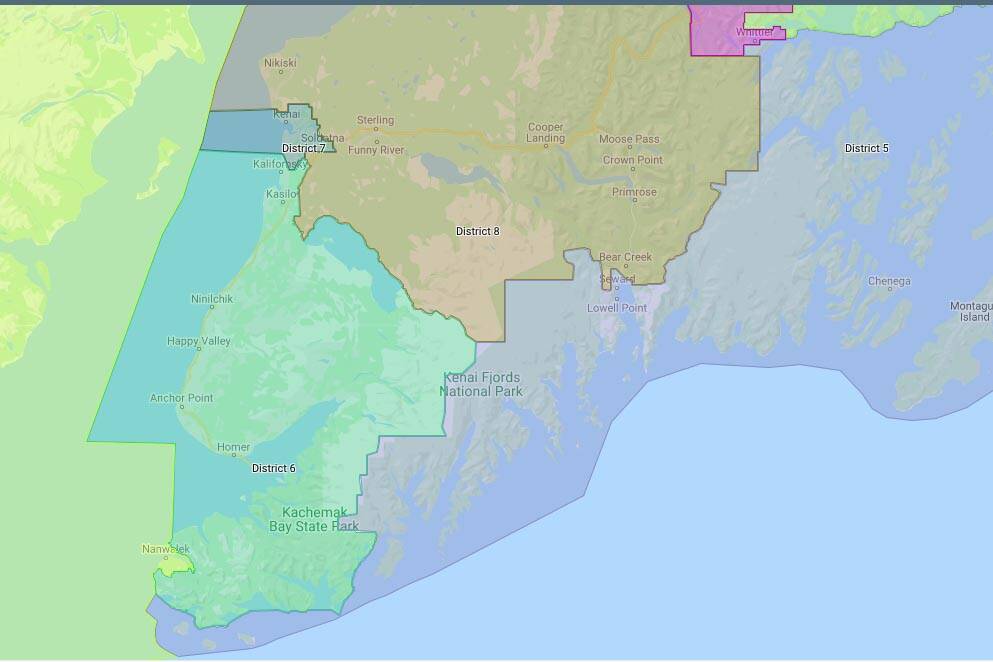Some areas of the Kenai Peninsula are gaining new residents at faster rates than other areas, and it’s skewing how they’re represented on the Kenai Peninsula Borough Assembly and on the Kenai Peninsula Borough School District Board of Education. That was made clear through new population data collected during the 2020 Census.
The need to reapportion the borough’s assembly and board of education districts comes from Alaska statute, which requires the composition and apportionment of assemblies to comply with the equal representation standards of the U.S. Constitution. The once-in-a-decade process is done using fresh population data produced by the decennial census.
The Kenai Peninsula Borough Assembly officially declared the borough’s assembly and board of education districts to be malapportioned through a resolution adopted last December. That resolution also authorized Assembly President Brent Johnson to put together a committee tasked with preparing reapportionment plans for both bodies by June 23.
“It is apparent from the unequal rate of growth in the incorporated and unincorporated areas of the borough that the existing apportionment of the Borough Assembly no longer meets this requirement,” the resolution says of the state and federal guidelines.
The target population for each of the nine districts is 6,533 people, but no district has exactly that many residents. That’s according to a memo prepared by Kenai Peninsula Borough Clerk Johni Blankenship for the committee.
The mean deviation for all districts is 159 people, but districts range in how far off their population total is. The Nikiski district, for example, has the largest deviation and has roughly 620 fewer residents than the 6,533 target figure.
The new reapportionment committee will help ensure all residents are more equally represented on the assembly and board of education by creating entire new apportionment plans.
Any plans put forth would then be subject to approval by the assembly and then put before borough voters during the Oct. 4 regular borough election, according to documents supplied to the reapportionment committee last month. Redistricting, which refers to the changing of district boundary lines, would occur after the election.
Both the borough assembly and the board of education are composed of elected representatives from nine single-member districts across the borough. Geographies represented by those districts include Kalifornsky, Kenai, Nikiski, Soldotna, Sterling/Funny River, Seward/East Peninsula, Kasilof/Central, Homer and South Peninsula.
Currently, one person is elected from each district by residents of that district. Other options allowable under Alaska statute include:
At-large seats elected by all borough voters.
By district seats voted on by all borough voters, but the candidate must live in that district.
By district members only elected by voters in that district.
Both at-large and by district.
The nine-person committee includes representatives from across the borough as well as Assembly President Brent Johnson. Virginia Morgan, Debbie Cary and Jason Taurianen are all members of the board of education and represent Cooper Landing, Ninilchik and Nikiski, respectively. Willy Dunne is a former assembly member from Homer, Crystal Collier is the president of the Seldovia Tribal Council and Sue McClure is the vice mayor of Seward. Hope/Sunrise Advisory Planning Commission Chair Jim Skogstad and Gary Davis of Sterling are also members.
Redistricting plans adopted by the Alaska Redistricting Board last November similarly shifted the boundaries of the peninsula’s state legislative districts. Seward, for example, will now vote with Kodiak instead of Nikiski for state races. The finalization of those plans came after months of public hearings conducted by the board as a way to gather public feedback.
The next meeting of the Reapportionment Committee is Feb. 23 at 1 p.m.
Reach reporter Ashlyn O’Hara at ashlyn.ohara@peninsulaclarion.com.


